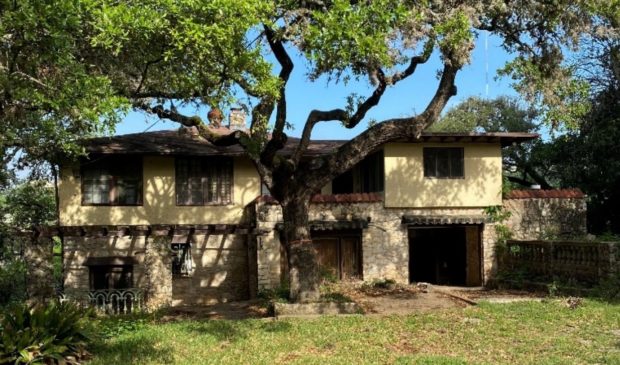Debate intensifies over owner-opposed historic zoning of lakefront estate
Monday, July 11, 2022 by
Kali Bramble The fate of a lakefront estate at 2002 Scenic Drive is now in the hands of the Planning Commission, with a battle over the property’s merits ending in victory for preservationists last Wednesday.
Citing architectural, landscaping and historical qualifications, the Historic Landmark Commission unanimously voted to recommend historic zoning for the two-story Spanish eclectic residence and accessory Gothic revival cottage. Still, the team behind the property owner maintains they have raised a sufficient counterargument.
The debate began in May, when the initial demolition request mobilized an outpouring of resistance from neighbors, including the West Austin Neighborhood Group and Preservation Austin. With photos of the home’s ornate stone craftsmanship and research into its 1920s origins, preservationists presented 2002 Scenic as an irreplaceable emblem of early West Austin settlement patterns.
“It is a unique surviving element of a small 1930s neighborhood anchored around what is now Scenic and Stevenson … a once vibrant little block of dwellings,” archaeologist David O. Brown said. “The houses of that early era had a warm, charming and almost magical feel to them … that will be lost when 2002 Scenic and its surviving early-20th-century neighbors are removed.”
The estate’s present owner had a different opinion, with a robust team of defendants depicting 2002 Scenic as little more than a deteriorating status symbol of a past generation’s elite. Real estate attorney Michael Whellan took particular issue with the commission’s shifting rationale for historic association, noting that the residence’s longest-standing tenants had a public history practicing segregation.
“I just am very worried about the way we sweep some of this historic association under the rug, and fail to acknowledge that there is precedent associated with (the commission’s) decisions,” Whellan told the Austin Monitor. “I think all we have here is an eclectic building that everyone thinks is quaint, built by a wealthy person who didn’t do anything for the city of Austin.”
Though initially built by optician and investor Raymond Delisle, the house was purchased by C.H Slator in 1945, whose family retained ownership until 2021. It was Slator who commissioned renowned architect firm Fehr & Granger to construct the adjacent Gothic revival cottage in 1946.
The descendant of a prominent Llano ranching family, Slator was best known for co-owning the Tavern, a historic pub that remains at 12th and Lamar to this day. But according to research by Whellan’s team, the pub was among the last of Austin’s institutions to serve Black people, refusing to integrate until forced by the Civil Rights Act of 1964.
The owner-backed team also raised the issue of accessibility, noting that 2002 Scenic Drive was four times farther away from public transportation than the average for landmarks designated for community value. While it was listed in the original motion to recommend historic zoning, the commission ultimately agreed to drop the community value criteria following disputes from commissioners Witt Featherston and Ben Heimsath.
Between Slator’s background and the home’s “isolated” West Austin context, Whellan argued that the preservation of 2002 Scenic Drive would represent “a failure to have an equity lens.” Following criticisms of racial bias in the historic landmark designation process, staffers are working to create a new equity-based preservation plan, aiming to take a draft to City Council by the end of next year.
Despite the many contestations, Commission Chair Terri Myers maintained that historic zoning criteria apply regardless of the neighborhood’s privileges.
“You’re sort of denigrating the community within which this property exists,” Myers said. “This community is just as important as any other in town. It doesn’t have to be a school, a church or a building associated with communities of color.”
Still, the estate faces difficult odds in its fight to remain standing. Aesthetic merits typically do not weigh as heavily in Council’s rationale for preservation, and even rarer are sites zoned historic against an owner’s wishes (there have been only a handful in the past five decades).
“I appreciate and listened to the opposition here, and it was an apt attempt to poke holes in the case,” said Commissioner Kevin Koch, who made the motion to recommend historic zoning. “I think the fact that it’s an outlier makes it a stronger case rather than a weaker case … and I think anyone would question our mission here and our right to be here if we didn’t recommend this for consideration by City Council.”
The Austin Monitor’s work is made possible by donations from the community. Though our reporting covers donors from time to time, we are careful to keep business and editorial efforts separate while maintaining transparency. A complete list of donors is available here, and our code of ethics is explained here.
You're a community leader
And we’re honored you look to us for serious, in-depth news. You know a strong community needs local and dedicated watchdog reporting. We’re here for you and that won’t change. Now will you take the powerful next step and support our nonprofit news organization?



